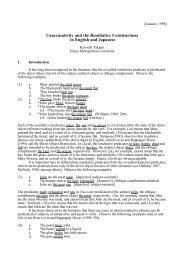Presuppositional Effects of Scrambling Reconsidered*
Presuppositional Effects of Scrambling Reconsidered*
Presuppositional Effects of Scrambling Reconsidered*
You also want an ePaper? Increase the reach of your titles
YUMPU automatically turns print PDFs into web optimized ePapers that Google loves.
Mithun 1992 examines the ordering <strong>of</strong> constituents in three languages: Cayuga,<br />
Ngandi and Coos. She points out that these languages pose a problem for the common<br />
assumption <strong>of</strong> theme-rheme (or topic-comment) ordering in that they exhibit the<br />
opposite rheme-theme (or comment-topic) order. 23 As a subcase <strong>of</strong> this tendency,<br />
Mithun discusses cases <strong>of</strong> what she calls “topic shift,” where an NP representing a new<br />
topic or a new point <strong>of</strong> view is placed at the beginning <strong>of</strong> the sentence when the topic <strong>of</strong><br />
the discourse shifts from one to another. While Japanese does not exhibit the<br />
rheme-theme order as a basic pattern, it is likely that what is happening in (56) is “topic<br />
shift” in the sense that the sentence-initial NP introduces a new topic (or a new point <strong>of</strong><br />
view). Thus, this NP should not be defocalized but receives another kind <strong>of</strong> focus,<br />
whose exact nature will be left for future research. Notice that this “topic” is different<br />
from those marked with the topic marker wa as in (57). While the wa-marked NP in (57)<br />
has a contrastive reading, the preposed object NP in (56) does not. Still, the preposed<br />
object NP in (56) plays a role similar to that <strong>of</strong> wa-marked NPs in that it serves as a<br />
topic. This suggests that not only the wa-marked topic but also this new topic (“topic<br />
shift” topic) is not included in TP. It follows then that it need not be contiguous with<br />
the presupposed verb. 24<br />
(57) Sono okane-wa dare-ga nusunda no?<br />
that money-TOP who-NOM stole Q<br />
‘As for that money, who stole it?’<br />
(58) and (59) further illustrate the “topic shift” in M-scrambling.<br />
(58) Taroo-wa sakana-o tutta. Sono sakana-o Hanako-ga nite tabeta.<br />
Taro-TOP fish-ACC caught that fish-ACC Hanako-NOM cook ate<br />
‘Taro caught a fish. Hanako cooked and ate that fish.’<br />
(59) Senba-yama ni-wa tanuki-ga otte sa. Sore-o ryoosi-ga<br />
Senba mountain in-TOP raccoon-NOM was that-ACC hunter-NOM<br />
teppoo-de utte sa.<br />
gun-with shot<br />
‘In Mt. Senba lived a raccoon. A hunter shot it with a gun.’ (Children’s play<br />
song)<br />
In (58), the first sentence introduces a fish into the discourse. The second sentence<br />
then turns to this fish and says what happened to it. The same applies to the raccoon in<br />
(59).<br />
A similar pragmatic role is played by NPs moved to the sentence-initial position by<br />
L-scrambling.<br />
23 Ojibwa, discussed in Tomlin and Rhodes 1992 also belongs to this category.<br />
24 The “topic shift” topic can appear in embedded clauses from which wa-marked topics are excluded.<br />
Possibly, the “topic shift” topic is adjoined to TP and the contiguity condition applies to only those<br />
elements properly included by TP.<br />
19



